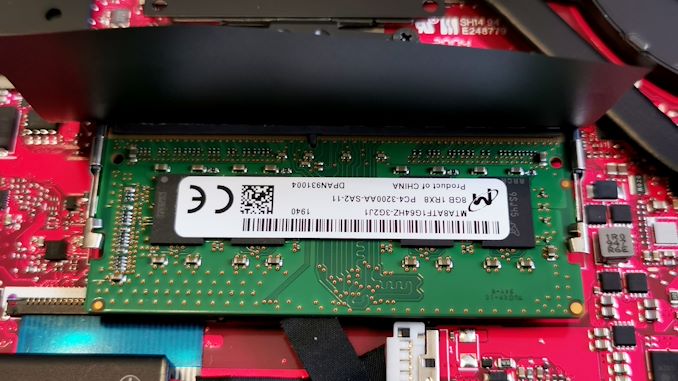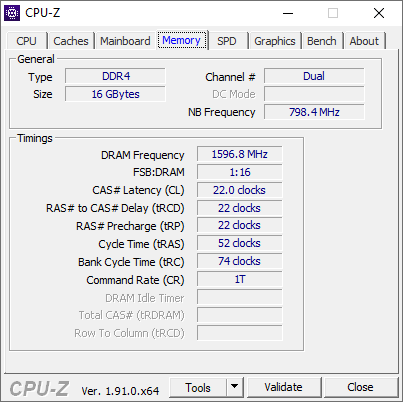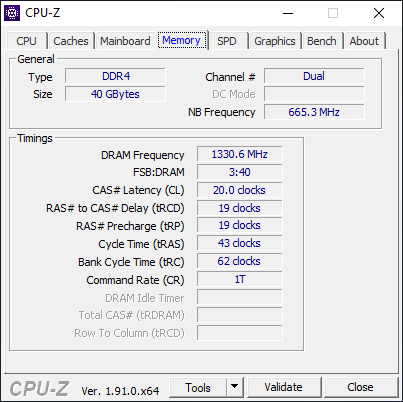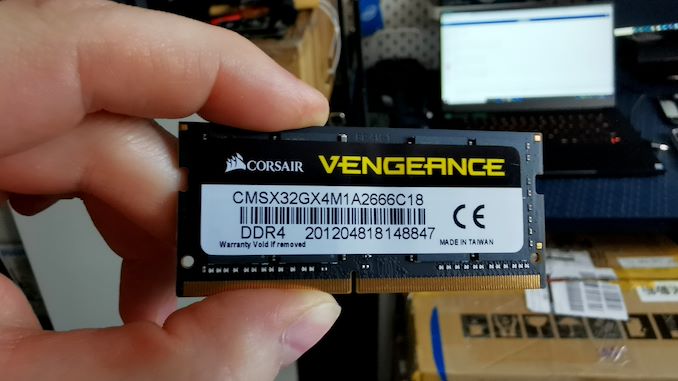AMD’s Mobile Revival: Redefining the Notebook Business with the Ryzen 9 4900HS (A Review)
by Dr. Ian Cutress on April 9, 2020 9:00 AM ESTRyzen 9 4900HS with DDR4-2666 and DDR4-3000
In our ASUS Zephyrus G14, we have a total of 16 GB of DDR4. This is split between a single SO-DIMM module of 8 GB, and a set of 8 GB memory soldered onto the board. AMD will offer a version with 16 / 16, however this might come at a later date.
This memory is running at the AMD recommended for these processors, DDR4-3200. Through our inspection tools, we can tell that this memory is running with subtimings of 22-22-22 with a command rate of 1T. The command rate is certainly good, however the 22-22-22 is a little slower than what we see on a desktop system running at this speed, because here we have a system that conforms to JEDEC’s subtiming requirements.
For our memory testing we wanted to see what speeds and capacities we could achieve. Corsair very kindly sent us some modules of 16 GB DDR4-3000 and a module of 32 GB DDR4-2666. This would give our system either 24 GB or 40 GB total respectively, which for a machine designed to do heavier duty workloads, having >16 GB is certainly welcome, as long as the performance hit isn’t too much.
I installed the 32 GB module, and the system booted first time with no fuss. A quick look to see if all the capacity was seen, and we had a total of 40 GB. The speed was also as expected, at DDR4-2666 but with subtimings of 20-19-19 1T.
However, when we put in the module of 16 GB DDR4-3000, to get a total of 24 GB, the detected speed inside the system was only DDR4-2666. Looking at the module settings, this was because the DDR4-3000 speed was actually an XMP profile, and ASUS has not enabled the ability to set XMP profiles here.
We were able to get DDR4-2666 on the 32 GB module because this is the base frequency and settings for the module. The same with the 8 GB module that came with the system – it was flashed so that the basic SPD setting was DDR4-3200. If users want to get high capacity modules with the faster DRAM speeds on this system, they will have to configure the primary SPD profile of their modules, which isn’t an easy thing to do.
As a result, our tests are going to come down to the 8 GB DDR4-3200 module that came with the system, and compare it to the 32 GB DDR4-2666 module. Note that the latter is an 8+32 configuration, which is expected to run in dual channel for the first 16 GB, and then single channel for the next 24 GB.



With our AI test, there’s a ~20% benefit from having the faster memory, which decreases slightly when moved to a limited power budget.

We didn’t see any difference in something like Cinebench.

There was more of a difference in PCMark 10, however PCM10 isn't that great in showing where the bottlenecks are.
Integrated Graphics Tests


For the Civ 6 graphics test, the difference in performance between the two memory settings is really significant. This sort of game cares less about FPS, however going down to 22 FPS for 1080p Max and No MSAA means that the user probably has to dial that back a bit to get something more reasonable.


Going from plugged in to not plugged in, we didn’t see much of a change with the slower memory, however the DDR4-3200 setting still gets a serious benefit over the DDR4-2666 arrangement.

For Final Fantasy, there a significant change - moving up from DDR4-2666 to DDR4-3200 affords a +30% improvement.
Discrete Graphics Tests




In each case, the faster DRAM actually improves discrete graphics performance.
Quick Thoughts
Overall, 16 GB of memory in a system like this isn't the best configuration - people who need the power are going to likely want 32 GB. However, users putting in their own fast module when buying the 16 GB version are going to have to be careful about the performance. Both the integrated graphics and the discrete graphics take a knock on performance going down from DDR4-3200 to DDR4-2666.















267 Comments
View All Comments
Slash3 - Thursday, April 9, 2020 - link
Yeah, that graph immediately threw a red flag.yeeeeman - Thursday, April 9, 2020 - link
How about some gaming battery life? Given this is a gaming laptop this is the most interesting scenario.Tams80 - Thursday, April 9, 2020 - link
About what you'd expect from a gaming laptop, so under two hours. And that's not really surprising as it's the GPU that's the main culprit there.haplo602 - Thursday, April 9, 2020 - link
The Intel CPUs boost to 60W when not on battery until they exhaust the thermal headroom. So removing their power cable is the only way to force them into a comparable power envelope.Just check the Civ 6 AI test and compare power from the wall for both ... there'll be a huge difference (even if you count in the GPU power difference).
TheCrazyIvan - Thursday, April 9, 2020 - link
Hanlon’s Razor - X-DHad to look that one up as I am no native speaker and did not know the phrase before - great reference!
The Von Matrices - Thursday, April 9, 2020 - link
What is the point of having a single DIMM? It doesn't make the laptop any better than having non-upgradable memory because if you do upgrade the module then you have an unbalanced memory configuration. Either make both channels use DIMMs or have soldered down memory.TheCrazyIvan - Thursday, April 9, 2020 - link
Well, there will be a time that DIMMs will have appropriate specs and where e.g. 40GB of total RAM will be in need - no matter the last 24GB being only Single Channel.GreenReaper - Monday, April 20, 2020 - link
Not sure it will ever be the standard, I suspect people will move to DDR5 first.Orkiton - Thursday, April 9, 2020 - link
There's a typo at last section ;-) S/b "Ryzen mobile 4000: a divine win for amd"ianmills - Thursday, April 9, 2020 - link
LOL I was wondering about that as "divine wind" means kamikaze. Not quite what AMD is hoping for this line!